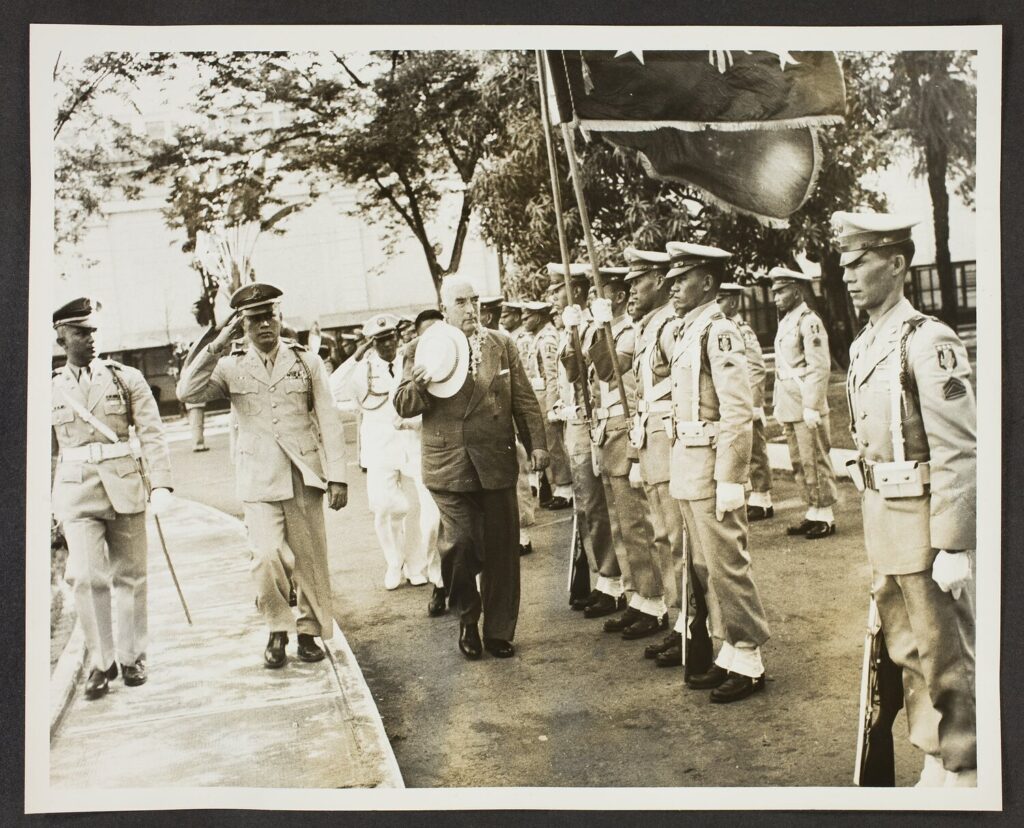On this day, 8 September 1954, the South East Asia Treaty Organisation (SEATO) was established as a result of the South East Asia Collective Defence Treaty signed in Manila. The Treaty complemented the ANZUS security pact to form the basis of the Menzies Government’s Cold War defensive strategy. It was primarily concerned with halting the spread of communism in South East Asia, a fundamental concern for Australia due to the prevailing domino theory which held that one state falling to communism greatly increased the likelihood that its neighbours would experience the same fate.
SEATO was directly modelled on NATO, however its scope was far more limited in that it did not provide for standing forces under a joint command, but merely prescribed collective action to meet a common danger in a similar manner to ANZUS itself. Treaty signatories included Australia, New Zealand, the United States, the United Kingdom, France, Pakistan, the Philippines, and Thailand. The provisions of the treaty also covered South Vietnam, Cambodia, and Laos, even though they were not signatories as they were prevented from signing military alliances by the 1954 Geneva Agreements that had brought to a close the First Indochina War.
Australia’s commitments under SEATO were not confined to defence. They also involved a large scale provision of foreign aid, which when combined with pre-existing aid commitments associated with the Colombo Plan would help to ensure that Australia’s foreign aid spending during the 1960s maintained a higher average than any other decade in our history. This apparent ‘generosity’ has been the subject of contemporary political debate, with some commentators comparing this legacy to the attitudes of modern-day Liberal Governments. The rationale behind Menzies’s aid spending was that if the nations of South East Asia developed economically and achieved a certain level of prosperity, their peoples would be less inclined to be induced by the promises of communist ideology. The bulk of Australia’s SEATO aid commitment went to the government of South Vietnam, which was seen as a country particularly vulnerable to communist agitation.
Perhaps the greatest and certainly the most controversial impact of SEATO was that the treaty was used to justify the collective international effort to defend South Vietnam from both North Vietnamese aggression and internal insurgents, and was thus part of the reason why Australia joined the Vietnam War via a commitment of ground troops in the final year of Menzies’s time in office. The primary rationale for Australia’s commitment was not SEATO itself, even though it was cited, but the domino theory which underpinned it. Australia also felt a strategic need to keep the United States interested in South East Asia and to prove itself a loyal ally deserving of the goodwill implied by ANZUS. Notably not all the members of SEATO became involved in the Vietnam War, even though the United States did try unsuccessfully to invoke the treaty.
SEATO would scarcely outlast the Vietnam War, being formally dissolved in June 1977. Reasons for the dissolution included Pakistani withdrawal in 1968, the French suspending their financial support in 1975, and the fact that SEATO was never directly invoked in the new conflict in Indochina and was thus rendered largely irrelevant by events. The evacuation of foreign troops from South Vietnam spelled the death knell of even the sentiment behind SEATO, as a country that theoretically should have been protected by the treaty was abandoned to its fate. SEATO has long been condemned as a failure, but recent historiography has argued that the treaty may well have had significant effect as a deterrent, and while it failed to resolve issues in Indochina which were prominent in its inception, it was far more successful in facilitating stability in places like Thailand.
Further Reading:
Robin Davies, ‘Measuring Australia’s foreign aid generosity, from Menzies to Turnbull’, Defensive Policy Centre, Policy Brief 16, February 2017.
Damien Marc Fenton, ‘SEATO and the Defence of Southeast Asia 1955-1965’, PhD Thesis, UNSW, 2006.
George Modelski, ‘Australia and SEATO’, International Organization, Vol. 14, No. 3 (Summer, 1960).
Sign up to our newsletter
Sign up for our monthly newsletter to hear the latest news and receive information about upcoming events.


